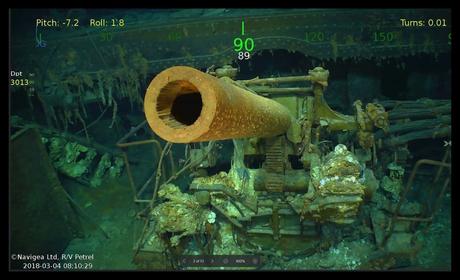 The U.S.S. Lexington, an aircraft carrier that was sunk during the crucial Battle of the Coral sea back in 1942 has been found by a research team funded by American billionaire Paul Allen. The ship was located about 500 miles (804 km) off the coast of Australia at a depth of about two miles under the ocean. The whereabouts of the Lexington have been unknown for more than 76 years.
The U.S.S. Lexington, an aircraft carrier that was sunk during the crucial Battle of the Coral sea back in 1942 has been found by a research team funded by American billionaire Paul Allen. The ship was located about 500 miles (804 km) off the coast of Australia at a depth of about two miles under the ocean. The whereabouts of the Lexington have been unknown for more than 76 years.On the final day of the battle, which was an important one in the early days of the U.S.' war with Japan, the Lexington was struck by a torpedo, followed by three bombs dropped from diving Japanese fighters. Within a matter of minutes, the ship was in flames, but the crew battled to keep it afloat. Two hours after the initial attack, she succumbed to the damage and the men on board were ordered to abandon ship.
The crew jumped into the warm waters of the South Pacific and were quickly rescued by nearby ships. According to Naval records, 2770 men survived the attack and sinking of the vessel. But the ship itself sank beneath the waters of the ocean and was never seen again. That is, until now.
Allen, who is one of the co-founders of Microsoft, bought a 250-foot researcher vessel called the R/V Petrel a few years back, and outfitted it with high-tech equipment that allows it to search beneath the surface of the ocean. The Petrel has been instrumental in locating other shipwrecks around the world, but the Lexington is its biggest find to date. The discovery was announced on Monday of this week, with Allen saying, “To pay tribute to the USS Lexington and the brave men that served on her is an honor. As Americans, all of us owe a debt of gratitude to everyone who served and who continue to serve our country for their courage, persistence and sacrifice.”
The Battle of the Coral Sea took place from May 4 - 8, 1942, just a matter of months after the U.S. entered World War II. Following the attack on Pearl Harbor, the Japanese fleet ran rampant over the Pacific, with little resistance from the Allies, most of whom were focused on the European Theater. In Australia, the fear was that a land invasion would come soon, as Japanese fighter planes and bombers made bolder attacks on the country.
Both sides suffered heavy losses in terms of ships and personnel, but in the end the Allies were able to prevent Japan from taking its main objective, which was Tulagi in the Salomon Islands. With their advance halted, the Japanese navy was forced to retreated, which set the stage for the Battle of Midway a month later, which was actually the turning point in the War in the Pacific.
Obviously the wreckage of the Lexington is going to stay on the bottom of the ocean, but it could be a focal point of research vessels moving forward. Since it is two miles under the sea, it will require some advanced equipment to reach it, but it would be fascinating to see what is inside. The video below gives us a glimpse at this massive ship, which was lost in the early days of WWII.

